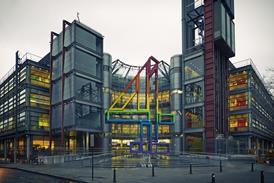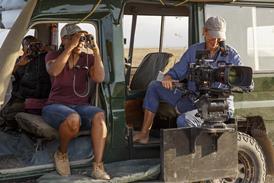A quiet revolution is sweeping the broadcast industry, radically altering the way in which programmes are made, worked on, stored and retrieved. The impetus behind the workflow revolution is twofold. First, there is the growing demand for delivering multiple versions of the same content for distribution to different platforms. And, second, at the other end of the production process, there is the growing range and sophistication of tapeless acquisition formats. The result is the demise of traditional linear workflow patterns. Individual craft workstations have already been replaced in post-production facilities by workflows centered around shared storage.
This model is expanding to encompass file-based capture at the start of the production process and file-based delivery at the end. As this transition occurs - and it will be many years yet before end-to-end tapeless workflows become widespread - the previously segmented boundaries between production and post blur.
Nowhere is the file-based workflow revolution more in evidence than at the BBC. The broadcaster's goal has been to migrate to fully tapeless and HD production by 2010. That ambitious target has now been reset as aspirational but nonetheless remains core to a massive internal project branded Digital Media Initiative (DMI) due to get underway from October this year. By removing tape from the workflow the DMI aims to break through the BBC's content divisional boundaries and create a single “digital repository” of information and content for use on multiple platforms.
“DMI encompasses a number of things but it is essentially about transforming the skills, processes and technology to enable end-to-end file-based production and delivery of our content to meet the needs of an on-demand world,” explains BBC Vision Studios technology controller Jon Attard.
BBC news, the BBC's radio production and Glasgow's Pacific Quay have already embarked on a digital overhaul to replace tape and enable collaborative multiplatform production. Next it's the turn of departments within BBC Vision, journalism, audio and music and information and archives.
Beginning with the Natural History Unit, children's and sport, the first£81m phase will begin this autumn in conjunction with technology partner Siemens.
“We will begin with those genres that are driving toward multiplatform and those starting to bank HD content,” explains Attard. “Phase two will extend DMI to other genres and regional sites. During this period we will assess key technical challenges such as how to roll out DMI in a way that meets the needs of Media City at Salford and the needs of external post-production and production suppliers.” A third phase will take the project to completion by 2012.
One key characteristic of the DMI initiative is that only new material will be automatically stored in digital form. There's simply not enough money to digitise the bulk of the 1.4 million hours of BBC back catalogue.
There are broadly three stages to the proposed DMI workflow initiative. In the first, all material is ingested into an online server, comprehensively logged and made available to producers collaborating across genres and across media. In the second, rough cuts are finished on craft stations and packaged for multiplatform delivery whether to HD master, encoding for mobile or distribution to playout partner Red Bee. In the third, copies of all final content are stored in a digital archive.
So how will the DMI initiative improve workflow efficiencies at the BBC? “Previously offline and craft edit suites were run separately and followed from each other in the production chain,” explains Attard. “Now that workflow will be more closely integrated.” In addition, before the introduction of DMI, the only way to share media was to dub out to tape and re-ingest. In future any producer can activate content on ingest.
Attard is keen to stress that DMI will be phased in rather than imposed with a big bang. “It's a very pragmatic approach,” he says. “We've asked each department what its editorial drivers and business needs are and worked back from that.”
Where previous step changes in production technology have been installed in discrete areas, DMI is an attempt to fundamentally overhaul root and branch processes so that every asset the BBC produces is accessible for reuse both internally and by the public. That ambition involves improving the BBC's ability to locate content. At present the corporation's blogging site Backstage admits that “our audiences can access our content faster than we can”.
Says Attard: “It becomes imperative to add clear descriptors whenever changes are made to content. One of the challenges for the production and craft community will be to pay close attention to new metadata (content description) guidelines. “They need to appreciate the impact that the information they add has on the production process and audience further down the chain,” he continues. “There might be a tendency under pressure to forget about metadata. That won't be okay in the future. Accurate and detailed metadata is critical in order that BBC content can be found by our audiences.”
Instead of a simple textual search mechanism the aim is to build a data model which will enable rich, intelligent searches across all content held in the digital archive. The ultimate goal is that content should be accessible whether a user is in Bristol, Glasgow or Manchester.
“Content from a factual production, for example, could be immediately sucked in and made available to news or entertainment. This opens up exciting opportunities for collaboration and creativity across divisional boundaries,” says Attard.
Producers, he says, will get used to the idea that other producers or members of a different team “may look at your hard- fought-for rushes at the same time as you. An online team is going to see material the moment you bring it back to base. The industry is competitive so this development represents a genuine cultural challenge.”
While the BBC's DMI initiative is the biggest example of how tapeless is revolutionising workflow, the move to tapeless is also affecting the workflow and workplace culture of smaller broadcasters and the post industry.
MTV Europe is upgrading its Camden HQ to accommodate a high-speed digital network that will distribute media to and from its US parent and European offices. According to MTV Europe vice-president, technology Dave Colfer: “The biggest issue is change management. How do you change to deal with files? What processes change? How does it alter roles and responsibilities? Any producer moving to file-based delivery faces a hefty task in terms of managing and accommodating cultural change.”
The introduction of tapeless camera formats is also finally beginning to affect post producers. “People are dabbling in tapeless formats often as a second camera for additional footage,” reports Evolutions operations director Owen Tyler.
Tiger Aspect took both Paul Merton-fronted documentaries (Paul Merton in China/India) to Evolutions after shooting on Panasonic's tapeless P2 camera. But, according to Envy chief engineer Daniel Sassen, producers must consider whether tapeless is right for their programme.
“The wrong choice could have major implications. The whole tapeless workflow fits the unscripted ‘reality television' model precisely, but it may not be quite so appropriate for drama or other scripted programming. Producers need to decide how important their rushes are to them once the show has been completed.”
Sassen adds: “Bearing in mind that a memory card is considerably more expensive (around£450 each for Sony's 16GB card) than its tape equivalent - based on 60 minutes' recording time - you would not hold a memory card ‘library' in the same way as you would hold a conventional tape library. The picture data needs to be copied from the memory cards to a hard disk for long-term storage or archive.”
Similar issues are being encountered by 3SixtyMedia as it begins to phase in tapeless production of 250 annual episodes of Coronation Street. “We still have the comfort blanket of tape as back-up but our biggest concern is how we decide on the life-cycle of media,” says head of post David Boyle. “Storing media on onsite archives (where it is readily accessible) is expensive so how long does it exist before we delete it and store in a deep (off-site) archive? Asset protection is perhaps the key. It means ensuring the data has been named accurately so we can track it.”
Lime Pictures has been recording the bulk of Hollyoaks direct to hard disk since 2001. Its new HD production will also record location-based material to the optical disk-based XDCAM HD to speed up the transfer of rushes into Lime's server.
“You should make the technology fit how you want to work and not let it dictate to you,” says Lime Pictures production server manager John Robertson. “It's perhaps easier [for us] posting just one production and using only a single file format whereas an external facility has to be able to handle multiple formats.”
The investment in disk storage and the fibre-optics that connect them is not inconsiderable. “We produce a high enough volume to justify the outlay,” says Boyle. “We know the work will keep coming for long enough for us to write off the cost.”
By recording feeds directly to a server the demarcation between production and post is even less apparent. “Since in theory we could edit rushes as soon as they're shot, at what point do we begin editing?” asks Boyle. “Do we create a special post media manager with responsibility for pressing the record button? These are some of the cultural issues we're having to address.”
High-def Hollyoaks
Lime Pictures is overhauling its in-house post facilities to accommodate the HD production of Hollyoaks for C4. Its HD facilities, which will be operational by June, centre on a 102 TB storage area network (SAN) to accommodate 650GB of material per episode. An additional 27TB of near online storage will retain material until transmission and then delete it. “We'll be acquiring four times the amount of data compared with SD but maintaining the same tapeless workflow,” says production server manager John Robertson. “Moving data won't be a problem once it's on the SAN.”
Corrie goes tapeless
Facility 3SixtyMedia is installing an Avid Isis central storage system that will eventually result in a fully tapeless workflow for ITV flagship Coronation Street. The soap is shot on DigiBeta but future productions may shoot studio material direct to disk and location work to file-based formats.
“The overriding factor is efficiency and economy,” says head of post David Boyle. “We currently ingest and go back out to tape four to five times in post. A tapeless workflow would eliminate that. Craft editing time remains the same. The chief savings of up to three days per episode comes in conform, online, grade and dubbing since media will remain on the server for everyone to access.”
The new infrastructure could also be used on stablemate ITV productions. “There is a bigger picture to this,” says Boyle. “We have an engineer dedicated to assessing whether this same system could be scaled to post Emmerdale.
“Beyond that we can see real benefits in the technology for distributing media to desktops for all ITV productions so everyone from researchers to producer-directors and execs can obtain ready access to material.”
Iron Maiden on the road
For Iron Maiden's current Somewhere Back In Time World Tour, restrictions on flight cargo meant the band's videographer Johnny Burke had to revise his normal production plans.
“Typically I would take as many flight cases as I wanted, including up to 12 cameras and hundreds of tapes, but since we're packing everything including 70 crew and all the stage set into a Boeing 757 I needed a much lighter set-up.”
Burke opted to experiment with the Sony EX1, a new camcorder that records to memory cards, hooked to a laptop running Final Cut Pro (FCP).
Burke produces packages on location for use by local broadcasters and also produces content for Maiden's official website.
“The big advantage is speed,” he claims. “I can take the cards straight from the camera into FCP and begin editing footage in HD within minutes.
I can do that on a plane or in a hotel room and have it ready for MTV when they want it.
“I was reluctant to use a new system on a new tour but if this works in the field, I'm not going back to tape.”

























No comments yet